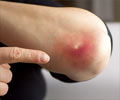New strategy basing on toxin activating could ward off the emergence of drug-resistant bacteria without killing beneficial bacteria.

‘Expressing toxins in bacteria and developing a genetic structure could help kill multidrug-resistant bacteria more precisely with low level of pathogen escape.’
Read More..




The discovery of antibiotics in the 1930s paved the way for unprecedented medical and societal progress. But the past 20 years have seen the emergence of bacterial resistance mechanisms which are spreading across the planet. Read More..
Few new antibiotics are being developed, and the time it takes from the introduction of a treatment to the subsequent acquisition of resistance is becoming shorter. Resistance jeopardizes our ability to treat infectious diseases, giving rise to disability and death.
When an antibiotic treatment is used, the therapeutic molecules attack all the bacteria in the microbiota. This non-targeted destruction leads to dysbiosis, in other words a disruption in the balance of the bacterial ecosystem that can result in the emergence of opportunistic bacteria or resistance to the antibiotic used.
The harmful impact of dysbiosis can be prevented by developing highly specific antimicrobial strategies. For example, the CRISPR-Cas9 tool can be used to target the resistance genes in pathogenic bacteria, but the rate of escape associated with the technique (when the pathogen manages to escape the various defense mechanisms employed by the infected organism) is relatively high.
In this study, a scientific team directed by Didier Mazel, Professor at the Institut Pasteur, developed an alternative strategy based on the specific expression of extremely powerful toxins delivered by conjugation. Conjugation is a process used by bacteria to exchange genes via plasmids, DNA molecules that are specific of bacterial genomes.
Advertisement
But one of the challenges of this method is how to control the sheer power of these toxins. We did this by separating their genes into two fragments, to make sure that they would only be effective if the two parts could be recombined," explains Didier Mazel, lead author of the paper.
Advertisement
They then refined this "weapon" further so that the toxin would only be able to target antibiotic-resistant strains of Vibrio cholerae. This involved creating a genetic module expressing a highly specific toxin inhibitor, an antitoxin, which is no longer produced when the bacterium contains resistance genes.
By combining these two procedures, they developed a genetic structure whose efficacy was verified in vivo in the complex natural communities of bacteria in the zebrafish and Artemia microbiotas.
"The level of escape for this alternative strategy is very low. It can be easily adapted for the specific destruction of several other pathogens. We now need to improve the process of gene delivery by the plasmid," concludes Didier Mazel.
A patent application has been filed by the Institut Pasteur and the French National Center for Scientific Research (CNRS) for the genetic tool designed by Didier Mazel and his team and for its applications. This European patent application (EP18306780) was filed on December 20, 2018 under the name Intein mediated protein splicing system for controlled expression of proteins - Use in the expression of toxins in target cells.
Source-Eurekalert












